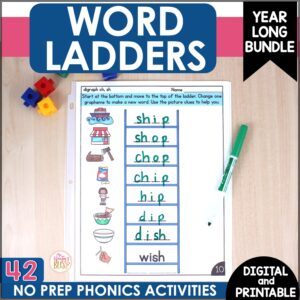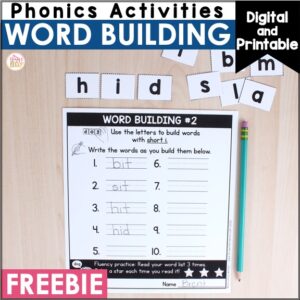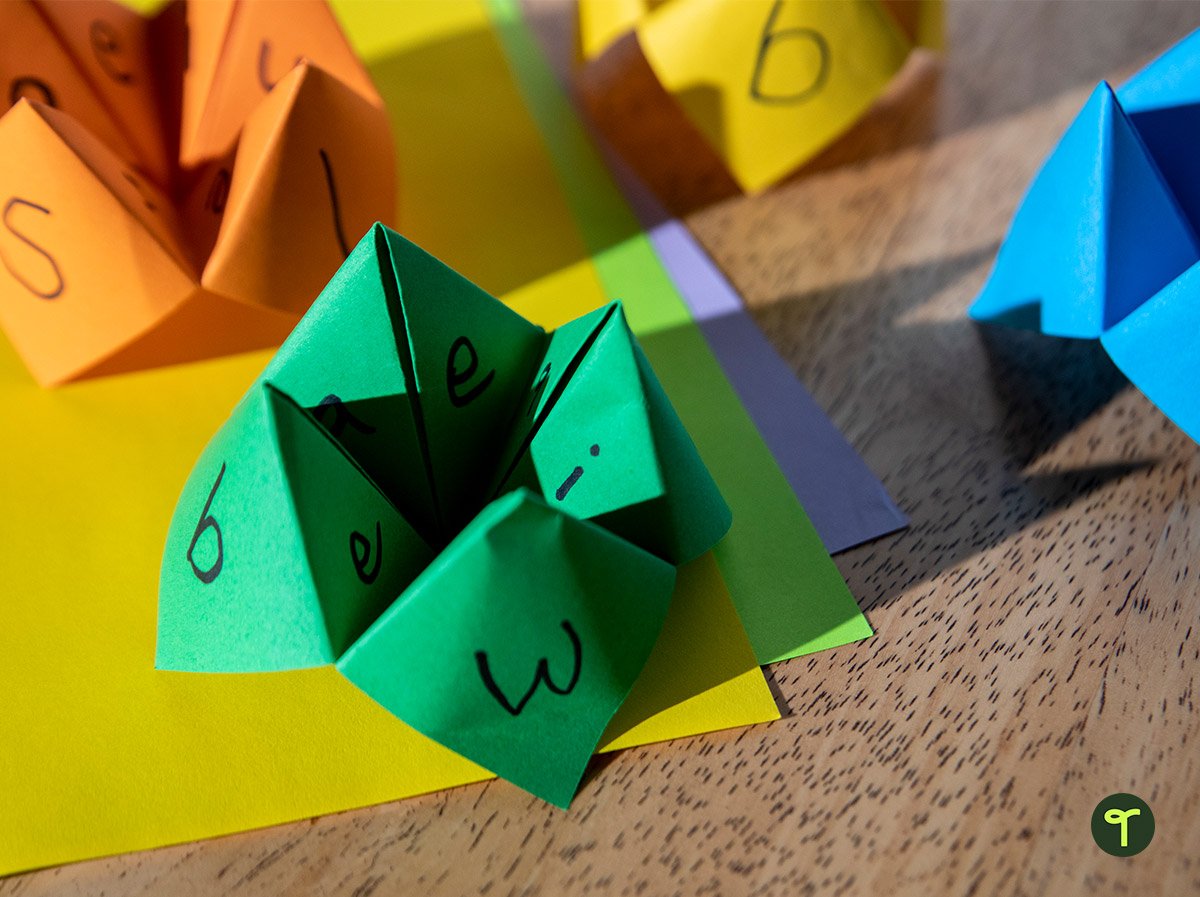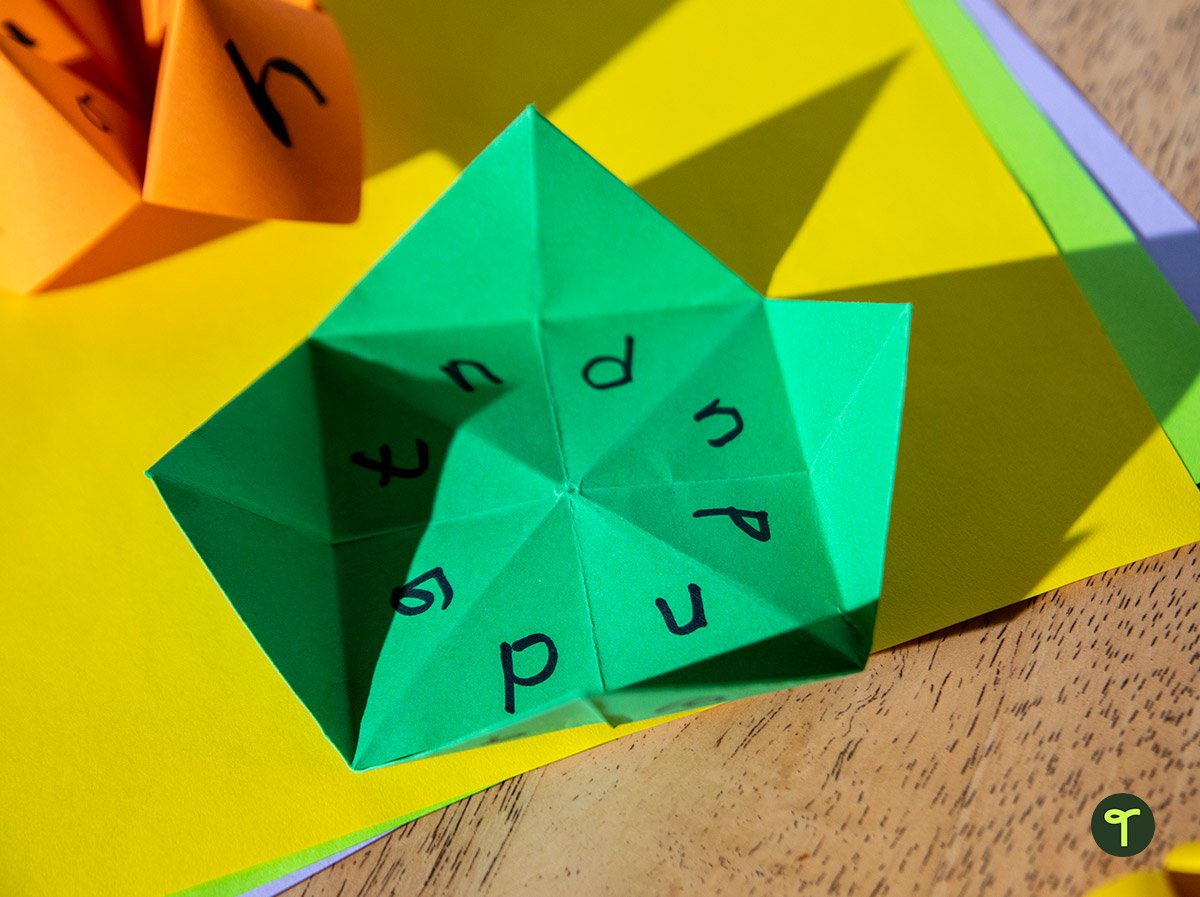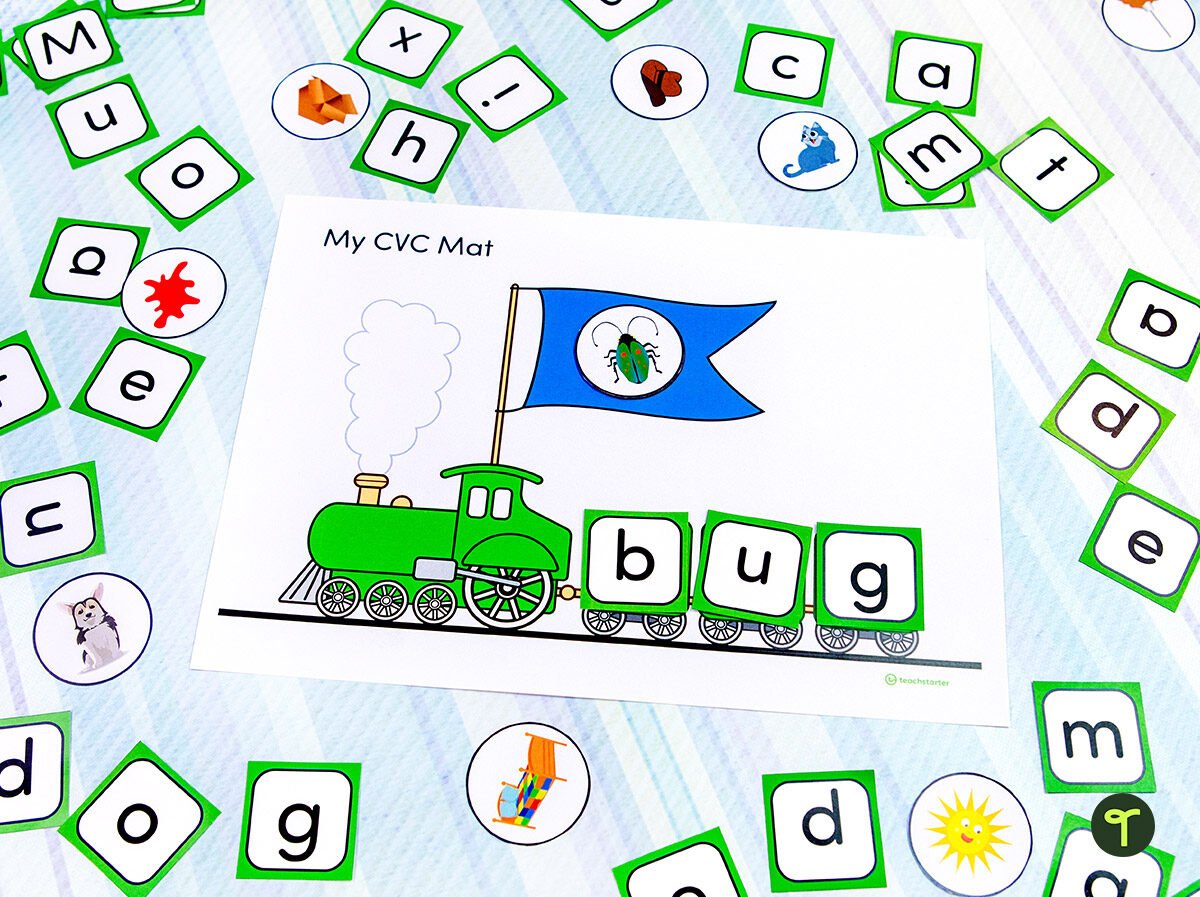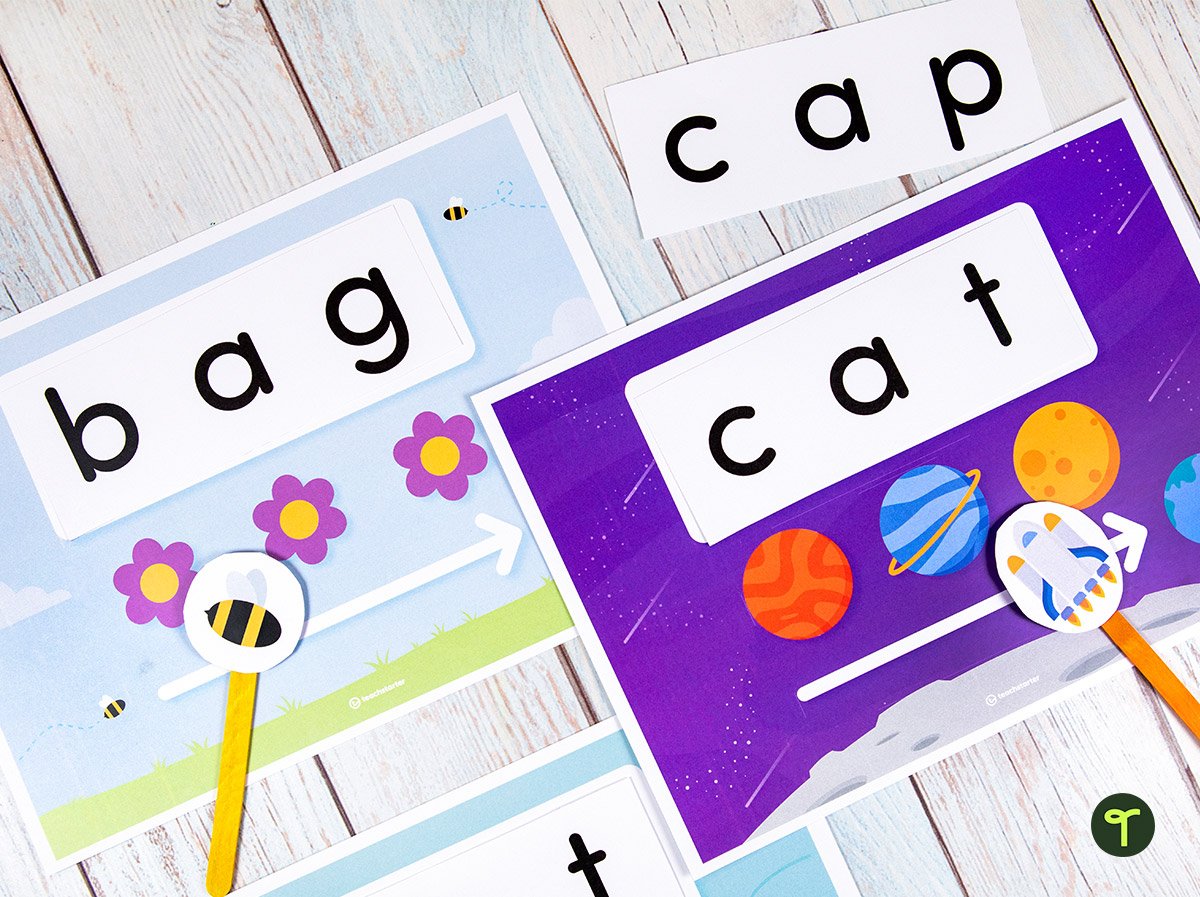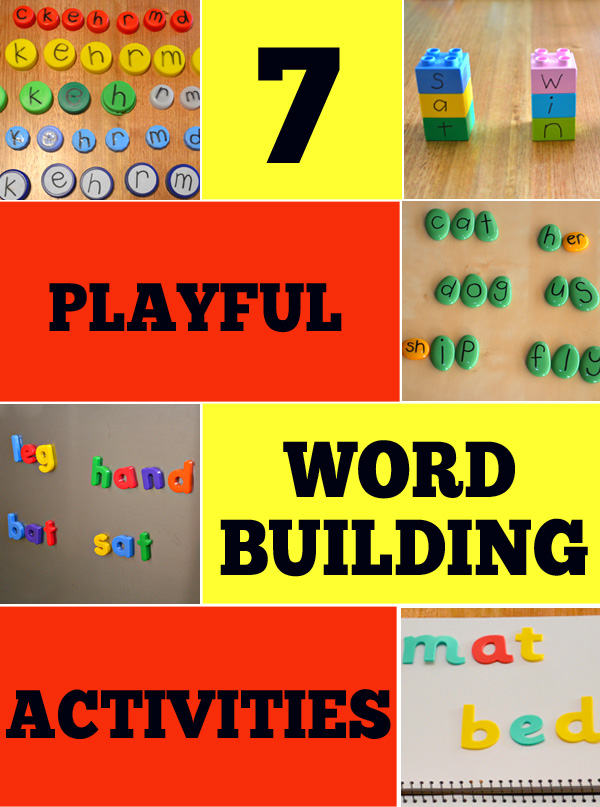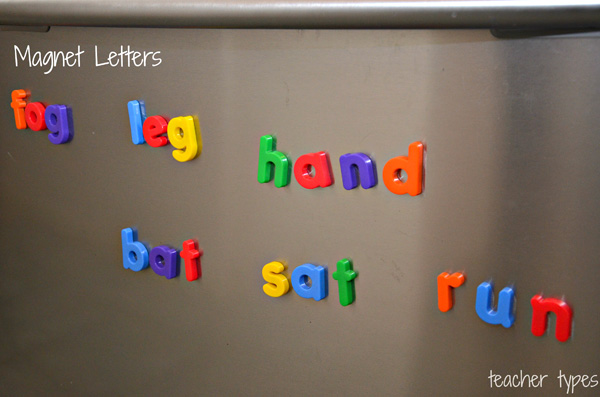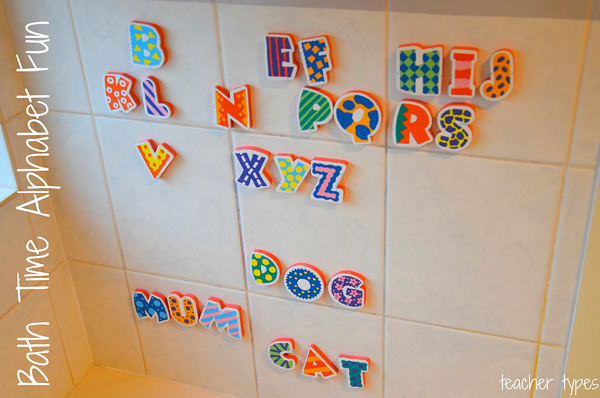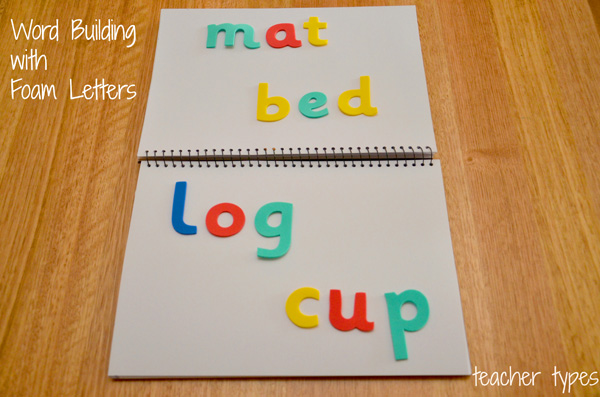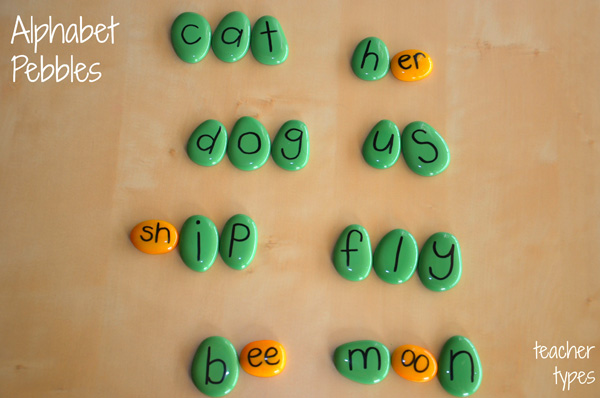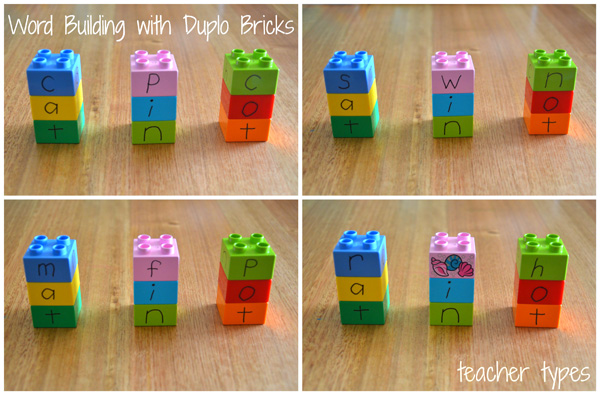Word building is a critical phonics activity. Students will develop word awareness skills as they explore and play with letter sounds to build words. Make sure to download the letter building cards and word building activities in this post.
One thing I love about teaching is that there is always the opportunity to learn, grow and become better. This past year I have spent a lot of time reading the work of Wiley Blevins. I’ve learned so much about phonics instruction and come to realize that there are aspects of the way I taught phonics that I would now change and improve.
One of my main takeaways from Blevins’ book, A Fresh Look at Phonics, is the importance of providing students with lots of opportunities for review and repetition in order to ensure they actually master the skills that we teach!
I realized that in my own teaching (and I confess!) I was guilty of exposing my students to a phonics skill, taking them through my weekly word study routine, and then moving onto the next skill the following week. I’m afraid I wasn’t giving them enough practice to ensure mastery.

Even if you know you need to provide this extra practice, it can be a challenge to come up with activities that effectively meet your needs. In his book Phonics from A to Z, Wiley Blevins suggests using word sorts and word building activities as a way to allow students to explore and play with letter sounds.
In my last blog post I shared all about word sorts, so today I’m excited to provide you with information about word building activities and share some resources to help get you started with these critical routines.
What are Word Building Activities?
In word building, students are given a set of letter cards and asked to create a series of words in a specified sequence. Usually, each new word varies by only one sound-spelling from the previous word. For example, students may build the following words in sequence: sat, hat, hop, mop. Each new word varies from the one before it by only one sound-spelling.

There are two types of word building activities, each with their own instructional purpose.
- Word Building: Blending Focus In this type of word building students are asked to make a word, such as cat. Then they would be asked to change the letter c to s and read the new word formed. The goal here is for them to blend, or sound out the new word. You can include many words with the new target phonics skill and also include previously taught skills.
- Word Building: Word Awareness Focus Here, students are asked to make a word such as cat, and then told to change it to hat. This requires a lot more thinking than blending-focused work. Students have to think about how the two words are different and which sound must be changed in order to form the new one.
Both of these word-building activities can be done with the same set of words, so incorporating both into your week gives your students good practice and saves you planning time!
Word Building Routines
The routine for word building is simple! First, introduce the task by naming it and explaining the purpose.
Next, MODEL! Place letter cards in a pocket cart to form the first word you are building. Model sounding out the word. As you build new words, be sure to include the new target sound-spelling as well as words with review sound-spellings. Use minimal contrasts to ensure students fully analyze the words and notice their unique differences. For example, sat/hat, mop/map, mad/made, cot/coat.
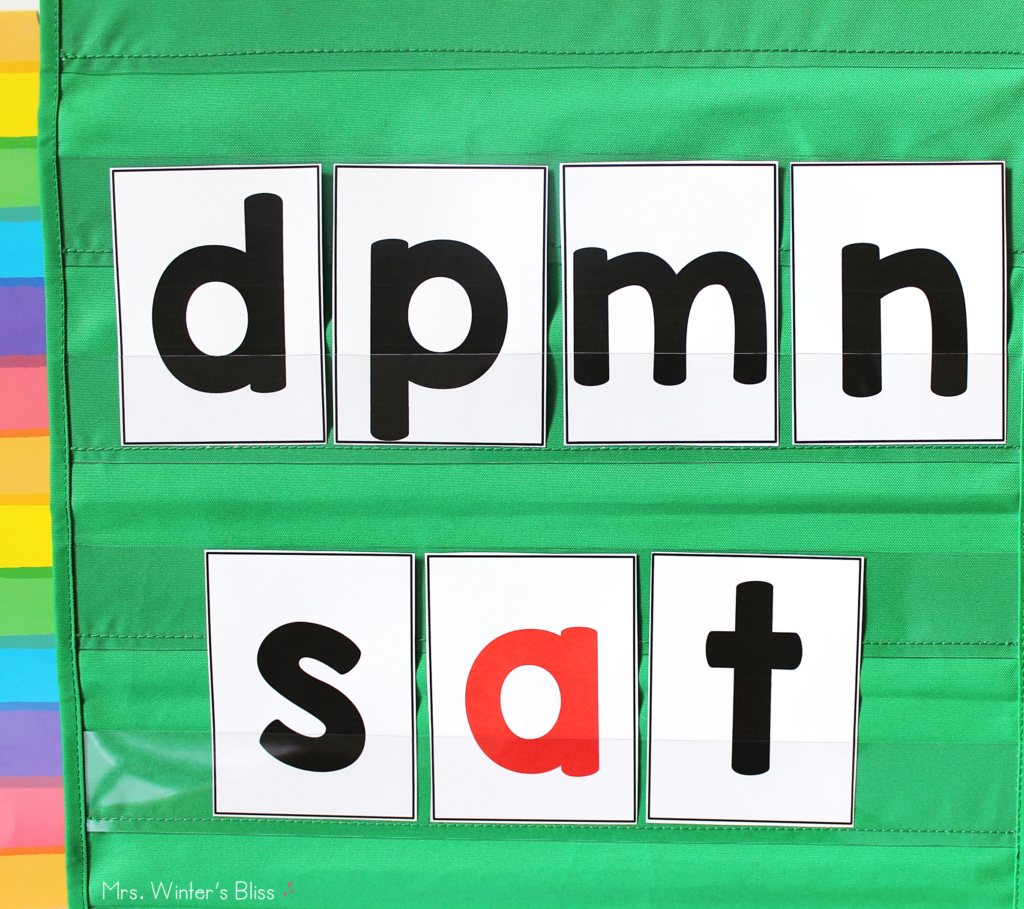
Download a set of these large letter cards for your pocket chart here!
Finally, provide opportunities for guided and independent practice. Continue to change one or more letters in a word and have students chorally blend the new word formed.

Make sure to have a word list prepared before the lesson in order to keep on track with the focus skill and review skills previously taught.

If you are working on word awareness (instead of blending) tell students what the next word is in the sequence and have them form it on their own. After giving them time, form the new word on the pocket chart and model your thinking aloud.
If you have fairly strong word building and word sorts routines in place, an engaging exercise to continue the development of word awareness is Word Ladders.
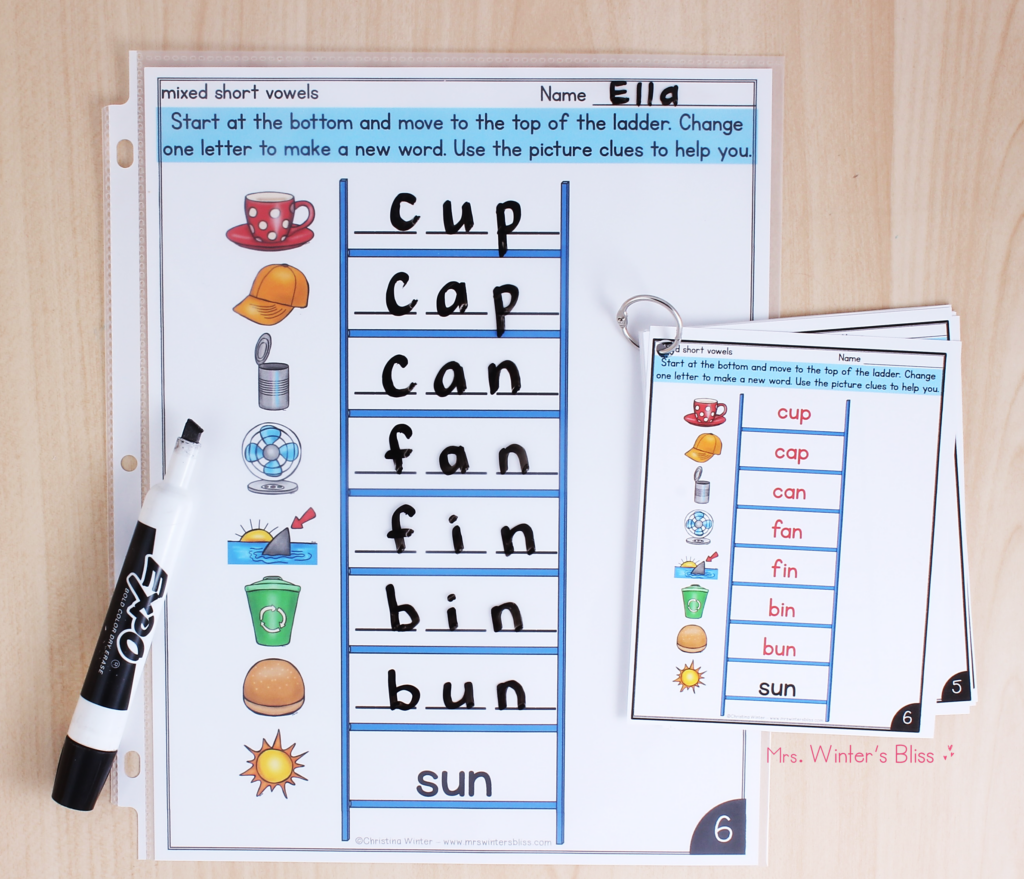
Word ladders are a fun and challenging word activity for students, and a great one to use towards the end of the week once they have had a lot of exposure to the word pattern. Since word ladders are self-checking they are perfect to use in an independent literacy center.
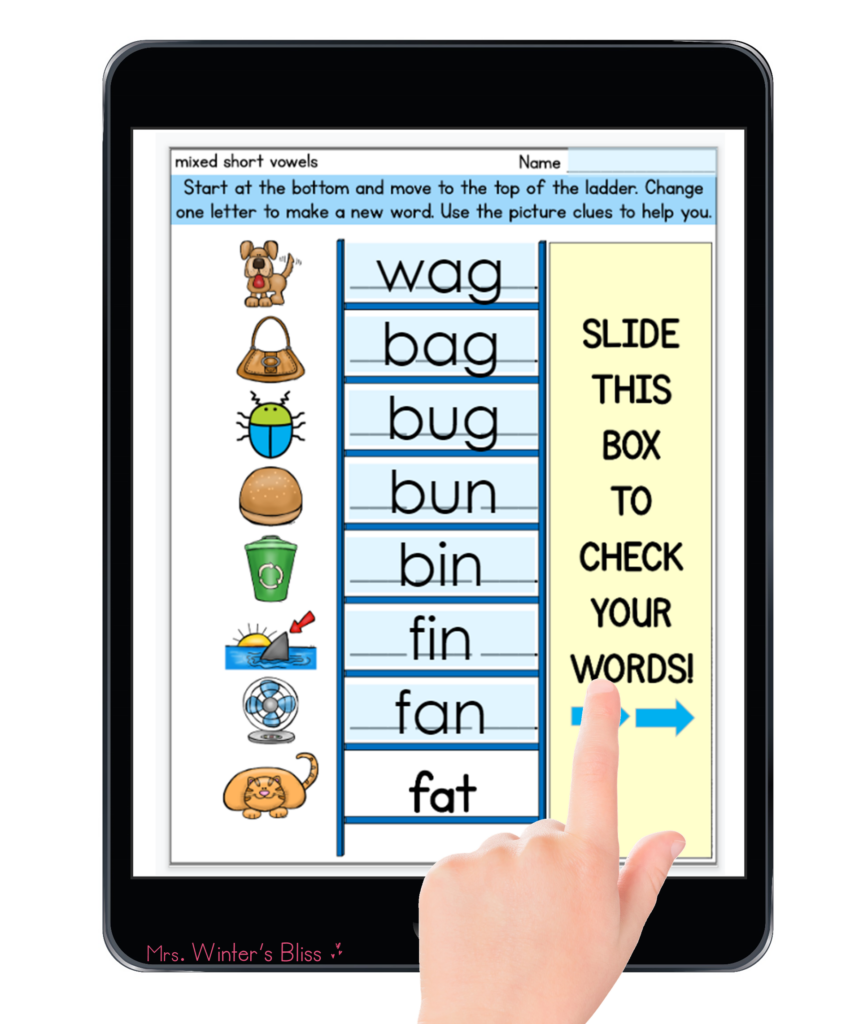
-
Phonics Word Building – Printables + premade Seesaw & Google
Product on sale
$24.50
-
Word Ladders Phonics BUNDLE – digital & printable
Product on sale
$10.00
Rated 5.00 out of 5 based on 2 customer ratings
Phonics Word Building Activities
Today I’m thrilled to share with you my very own Phonics Word Building Activities! These DIFFERENTIATED activities are both printable and digital so you can use them in the classroom or for distance learning with Google Classroom & Seesaw!
Students will listen to the AUDIO directions (from yours truly!) and then build words in a specified sequence. Each new word only varies by one sound spelling from the previous word. Students press the audio button to hear me state the word to build, blend the phonemes of the word, say the word again, and use it in a sentence to develop vocabulary.
This resource includes:
- 31 teacher-directed digital word building lessons
- 31 printable word building lessons
- master word list
Each of the 31 lessons focuses on one phonetic pattern:
- Short Vowel (CVC) Words
- Digraphs
- Blends
- Long Vowels
- Diphthongs
- R-Controlled Vowels
- Complex Vowels
Get started now by downloading your FREE phonics word building activities here:
-
FREE Phonics Word Building – Printables + premade Seesaw & Google
$0.00
Rated 4.75 out of 5 based on 4 customer ratings
Word Ladders
This resource includes both printable and digital word ladders that require students to think critically to figure out the next word to build, using letter or picture clues for support! Students will change just one letter to build a new word.
Included in this resource are 42 word activities- enough to last you the entire year!
Included Phonics Patterns:
- CVC Words
- Digraphs
- Blends
- Long Vowels
- Diphthongs
- R-Controlled Vowels
- Complex Vowels
Both of the Phonics Word Building activities and the Word Ladders provide students explicit and systematic practice. All of the activities in both of the resources are based on Wiley Blevins’ recommended scope and sequence for K-2 students. You can be confident that they are developmentally appropriate and provide the scaffolding students need for mastery.
EASY TO PREP AND MANAGE!
One of the major pitfalls with some word sorts is that they often require a lot of small pieces of paper, letter cuts, or word cards. They can take a long time to prep, distribute, and collect!
But NOT these activities! The printable pieces require very few cuts for students. There will be NO TIME wasted dealing with materials!
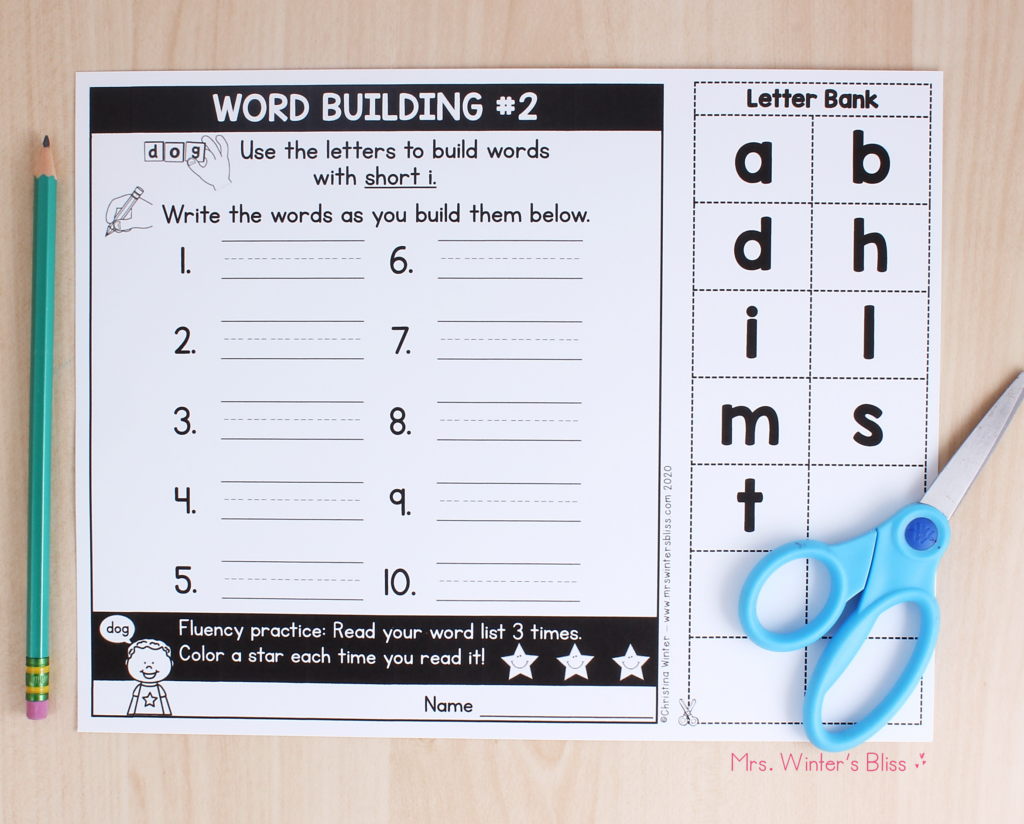
The digital versions have been PRELOADED for you. With 1 click you add them to your Seesaw library or Google Drive and then you can assign them to your students for remote learning or individual centers!
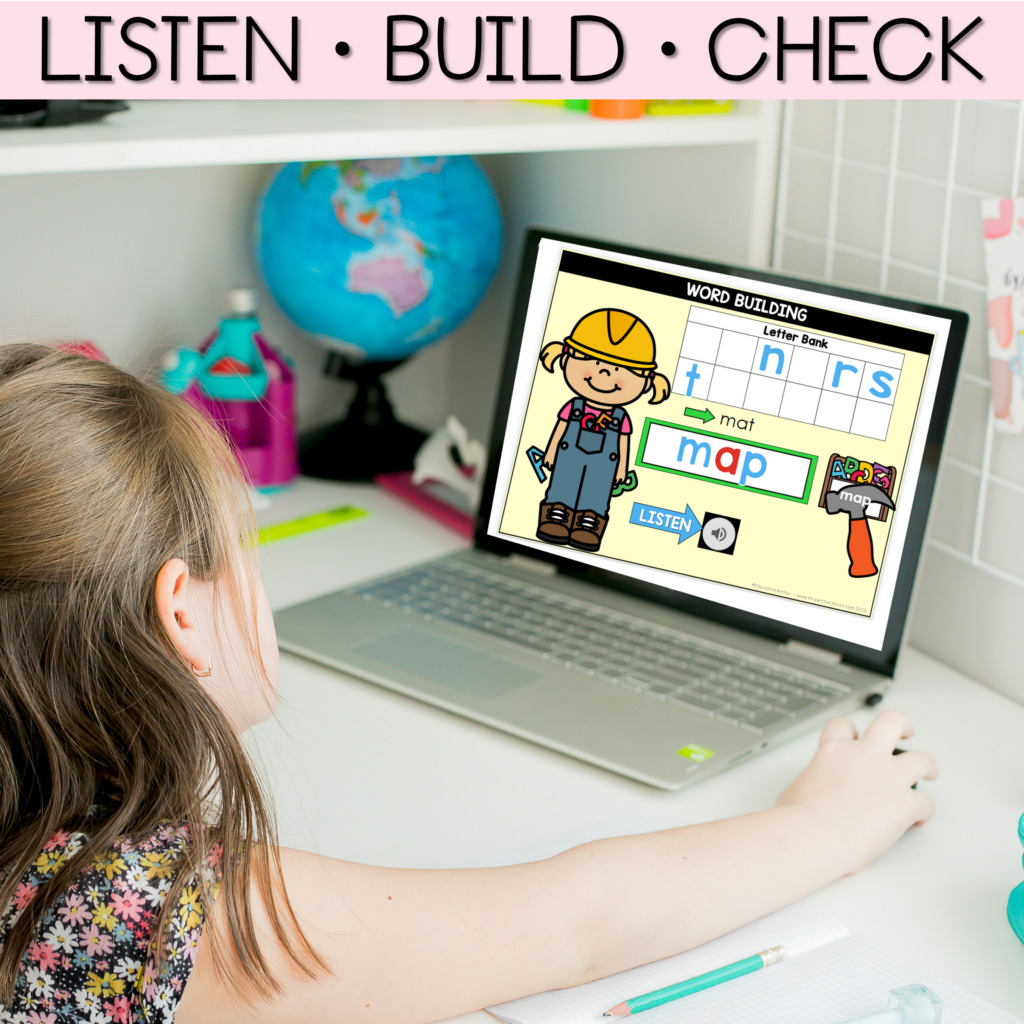
Another BONUS is that the structure of each activity in both of these resources remains the same. This saves you from having to explain and model every time you assign one! Once your students have successfully completed one, you can be sure they’ll be able to independently work through the rest at whatever pace you assign them!
I hope the Phonics Word Building Activities and the Word Ladders I’ve shared today will help you provide your students with meaningful practice that will help them to develop their word awareness and master their phonics skills!
–PIN for LATER–

-SHOP THIS POST-
-
Phonics Word Building – Printables + premade Seesaw & Google
Product on sale
$24.50
-
Word Ladders Phonics BUNDLE – digital & printable
Product on sale
$10.00
Rated 5.00 out of 5 based on 2 customer ratings
Word building activities help form the foundation of a child’s reading journey. These activities allow a child to actively participate in blending and segmenting graphemes to create words. As word building activities rely on constant repetition – coming up with fun ways to engage young minds can be tricky, check out some of these great ways to incorporate word building activities into your classroom.
What are Word Building Activities?
Put simply, word building activities are where students are provided with a variety of graphemes, usually on ‘moveable’ items such as paper, magnets, blocks etc, that they can manipulate to create words. Word building helps students to:
- understand how letter symbols relate to letter sounds
- segment a word into it’s graphemes
- blend graphemes to create the spoken word
- isolate sounds in words
- identify spelling patterns.
To help with the above skills, there are a variety of word building activities that you can do with your students. I would introduce these activities together as a whole class to explicitly show the different word building activities they will complete.
- Isolate sounds – students need to identify the first, middle and end sound in a word that you have created on the board using magnetic letters.
- Build the word – say a word, but mix the letters up on the board. Tell the students we’re going to build the word together and work out the beginning sound and the corresponding letter, then the middle, then the end.
- Substitute sounds – create words by changing one sound in the word. For example, changing the /s/ in sat to an /m/.
- Delete sounds – if i start with the word sat and I take away the ‘s’ what do i have now?
- Add sounds – the reverse of delete, if we add an ‘s’ to the start of the word ‘at’ what word do we have now?
- Identify patterns – through a list of words – identify ‘patterns’ in the spelling of the words. For example, in watch, wash, wand – the ‘a’ in these words makes the /o/ sound.
Word Building Resources
How to Make Magnetic Letter Tiles for the Classroom
This is a game changer when it comes to having the tools and resources ready to go in the classroom – you can actually purchase magnetic paper! This is perfect for both whole class instruction as well as independent word building activities.
- Purchase a pack of magnetic sheets, we found these at Office Works.
- Download the My Word Builder Folder.
- Print the letter tiles using the magnetic paper.
- Cut the tiles out.
- Store a set in one container – you may like to use multiple containers to keep sets together.
How to Make a Word Building Chatterbox
Once a those little hands in your classroom learn how to create a chatterbox.. you’ll have a chatterbox thrown in your face at every spare moment in the day! They love to master the folding and coming up with things to put in their chatterbox. Why not jump on this obsession and create a word building chatterbox for the classroom.
Obviously you’ll need to think of the letters that would be written – there are usually three levels so this is perfect to practice CVC word building.
Word Building Printable Activities for the Classroom
Along with some of these great hands-on word building activities, there are some great printable word building activities that you can print and have use time and time again.
Train Carriage Word Building Mat
This concept is cute for little learners. Each of the train carriages holds one phoneme. But, once the carriages are full the train moves along and you can blend those graphemes to create a word!
These printable Segmenting and Blending Mats are very similar to the above activity, and while they are initially created for blending and segmenting specific words – you could easily cut up the graphemes so that students are building the words themselves.
Word Building Activities for All Ages
The above activities may be a little bit babyish for the students in your class, this doesn’t mean that word building stops after students have grasped simple CVC words. In fact, continuing to use word building activities throughout primary school is hugely beneficial. Here are some great word building activities that work for for all ages:
- Play Wordle for Kids.
- Use the magnetic tiles but just build harder words!
- Pick a focus phoneme and have students create as many words as they can with a variety of graphemes.
- Students become graphemes – this is a fun activity where a number of students wear large grapheme tiles on their shirts, but they can’t talk! Their classmates need to put them in order to create as many words as they can in a certain time frame.
- Play word ladder. This is where students are provided with a word such as ‘blank’ then they are given a clue and need to change one letter to create another word. For example change ‘blank’ into the word that means – eyelid closes and opens.
Check out our range of Printable Phonics Resources.
This simple building block activity for kids is a great way to support your child as they learn to read and spell. Using whichever building blocks you have at home you can start to blend the phonemes (letter sounds) that make up the words we read. Children can use them to build and read real words or you can see how they are getting on with phonics knowledge by making up some nonsense words. So here you go a simple hands-on activity for building basic words with blocks.
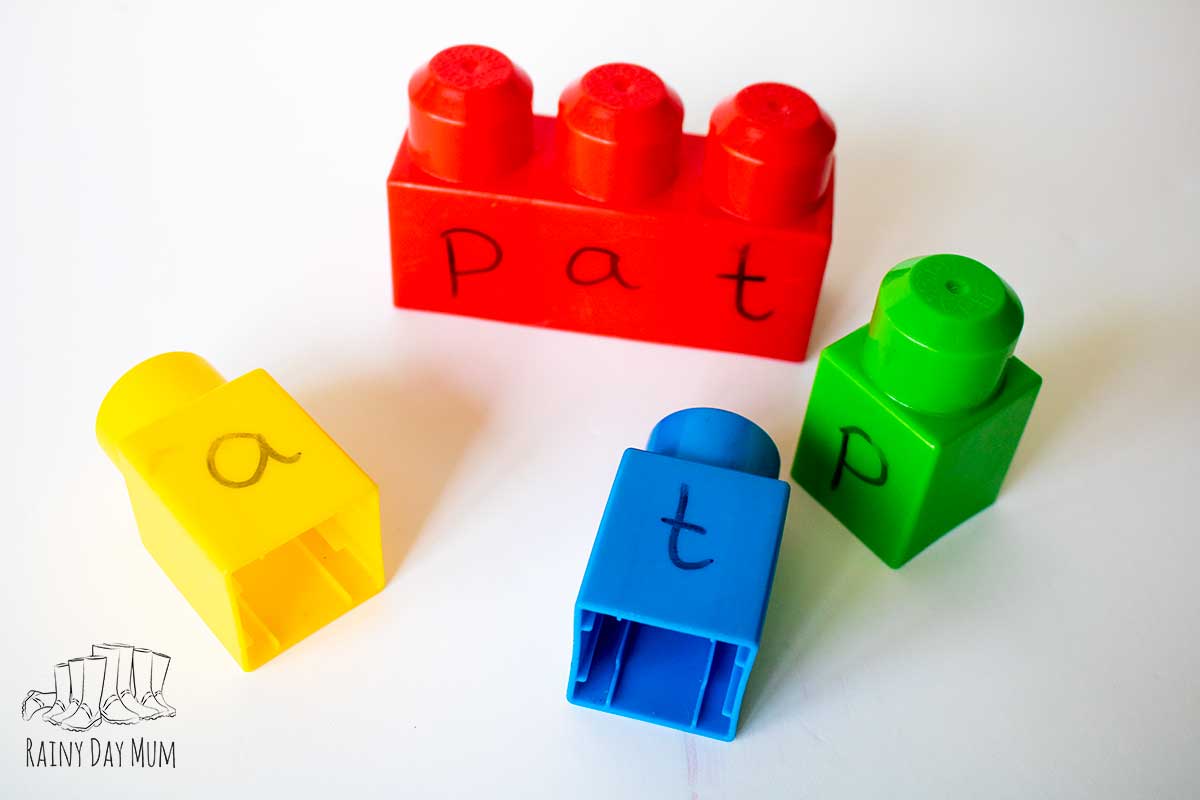
What You’ll Find on This Page
What is a Word Building Activity?
A word building activity is a simple hands-on activity that uses knowledge of letter sounds to build some basic words. They can be used for word families just changing 1 letter at a time or you can use some of the common sight words and practice spelling and reading them.

What words to use with this Word Building Activity?
We like using simple words as we first work on blending sounds. As in the Rainy Day Mum house we used Jolly Phonics and Letter and Sounds as our basis we first introduced this activity with the first 4 letters S, A, T, P, and then expanded on it with more letters as we covered more sounds.
The following words can be made with just those 4 letters to start:
After SATP we introduced the next 4 letters – INMD combining these with the previous set there were a lot more options of words we could build with the blocks check out these ones:
- am
- an
- and
- as
- at
- dad
- did
- dim
- din
- dip
- in
- is
- it
- mam
- man
- map
- mat
- men
- mid
- min
- nap
- nip
- pan
- pat
- pin
- pip
- pit
- sad
- Sam
- sat
- Sid
- sip
- sit
- tan
- tap
- tat
- Tim
- tin
- tip
When you are working with letters and learning to read this is an ideal time to introduce the activity, select the blocks you will need, add in some letters and follow the instructions below.
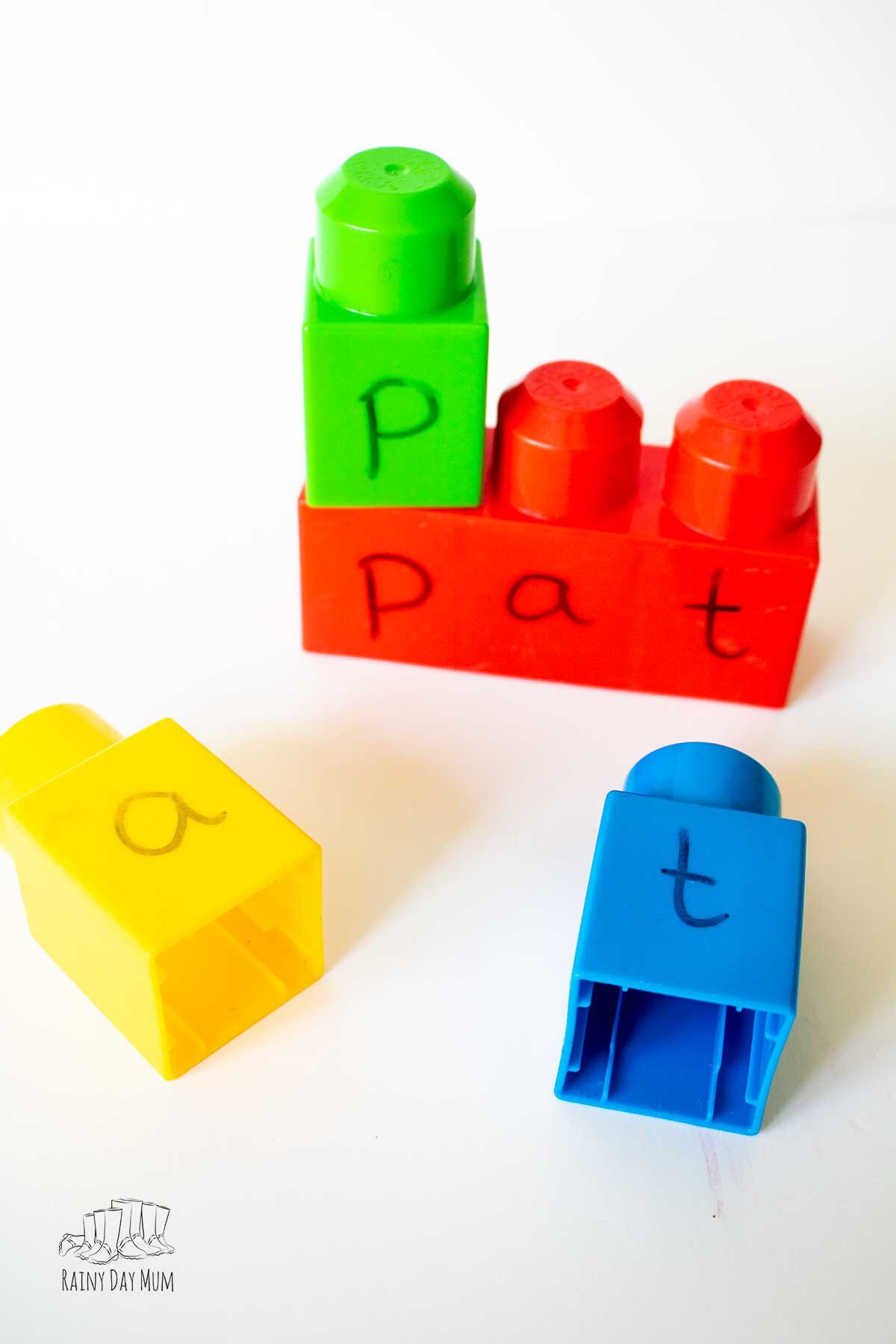
Materials Needed to Build the Word
- Lego Duplo or Megablocks
- Erasable Marker
How to Use Your Word Building Activity
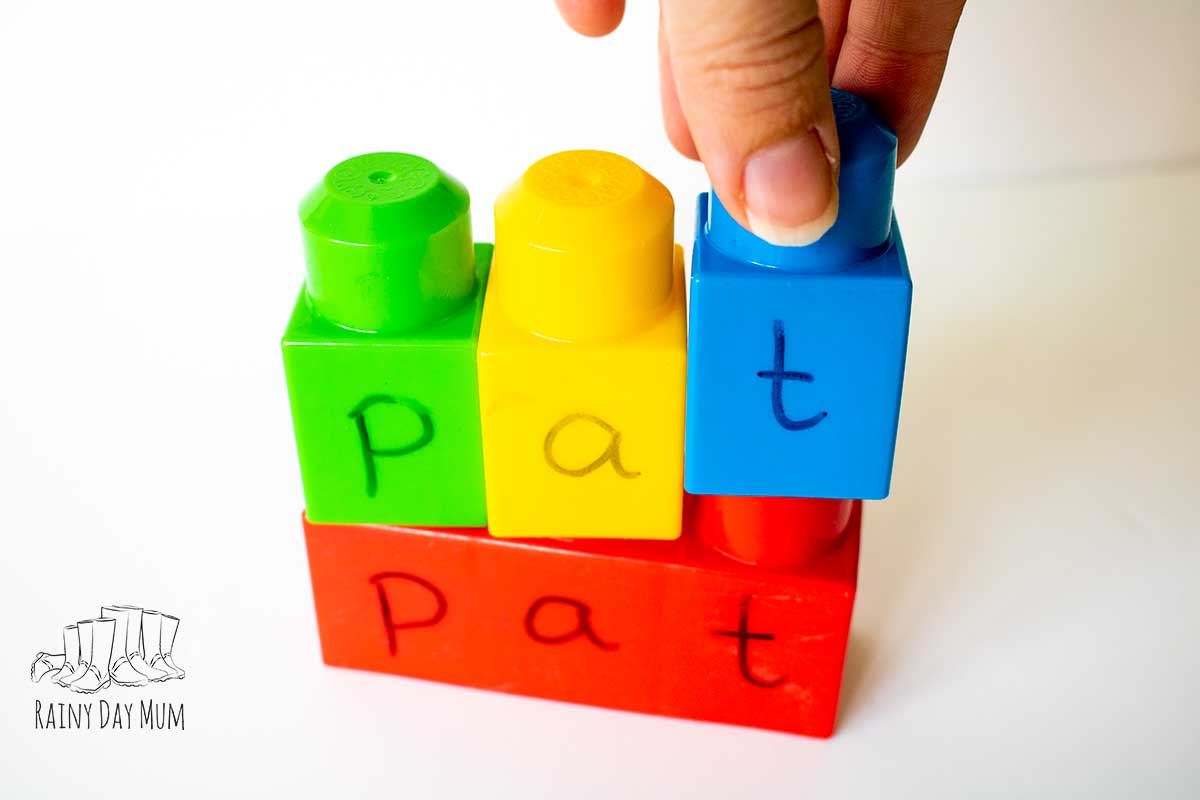
- Find a long brick that is the correct length for your word. For example, for ‘cat’, you need a ‘3-piece’ block.
- Write your word on the block and space out the letters.
- Take single blocks (each of a different colour). Use 1 block for each letter in the word. E.g. c-a-t.
- Write your letters (graphemes) – one letter on each block.
- Your child then recreates the word using the single blocks and attaching them to the larger block in the correct order.
Extending your Mega-Block CVC Activity
Wider choice of letters
So your child has a choice of 3 letters to make a 3 letter word and can quickly put them in order? Add some challenge. Can they make the 3 letter word when choosing from 5 letters, 6 letters, 10 letters? Simply make up extra single blocks to add the choice.
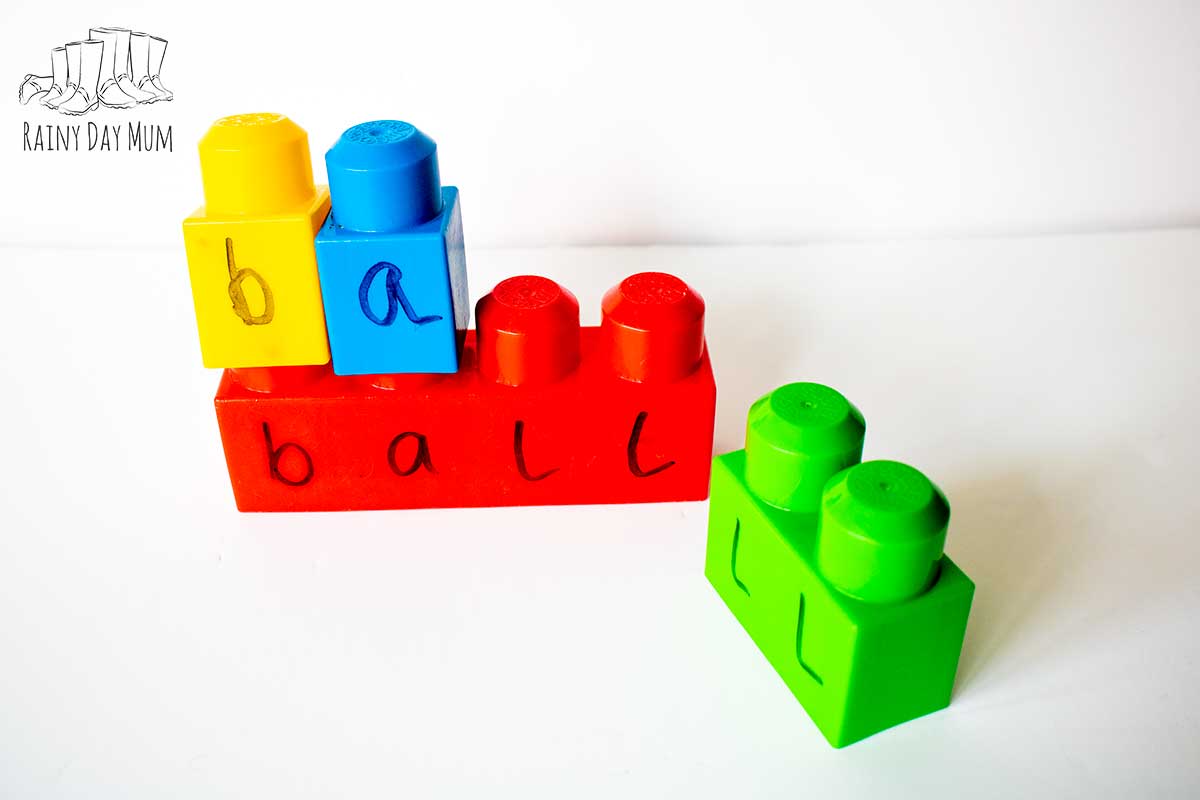
Missing letters
Don’t give your child all the letters!
Let me give you an example. You write ‘cat’ on your ‘3-piece’ block and write letters on 2 single blocks and leave the third block empty. Can they build the word and tell you the missing letter?
EXTENSION: Can they write the missing letter?
Capital letters
Try writing your big block in capital letters and your single blocks in lowercase (not capitals) letters. Your child will have to process the letters more to match these to build the word up.
Adjacent consonants, digraphs, and trigraphs
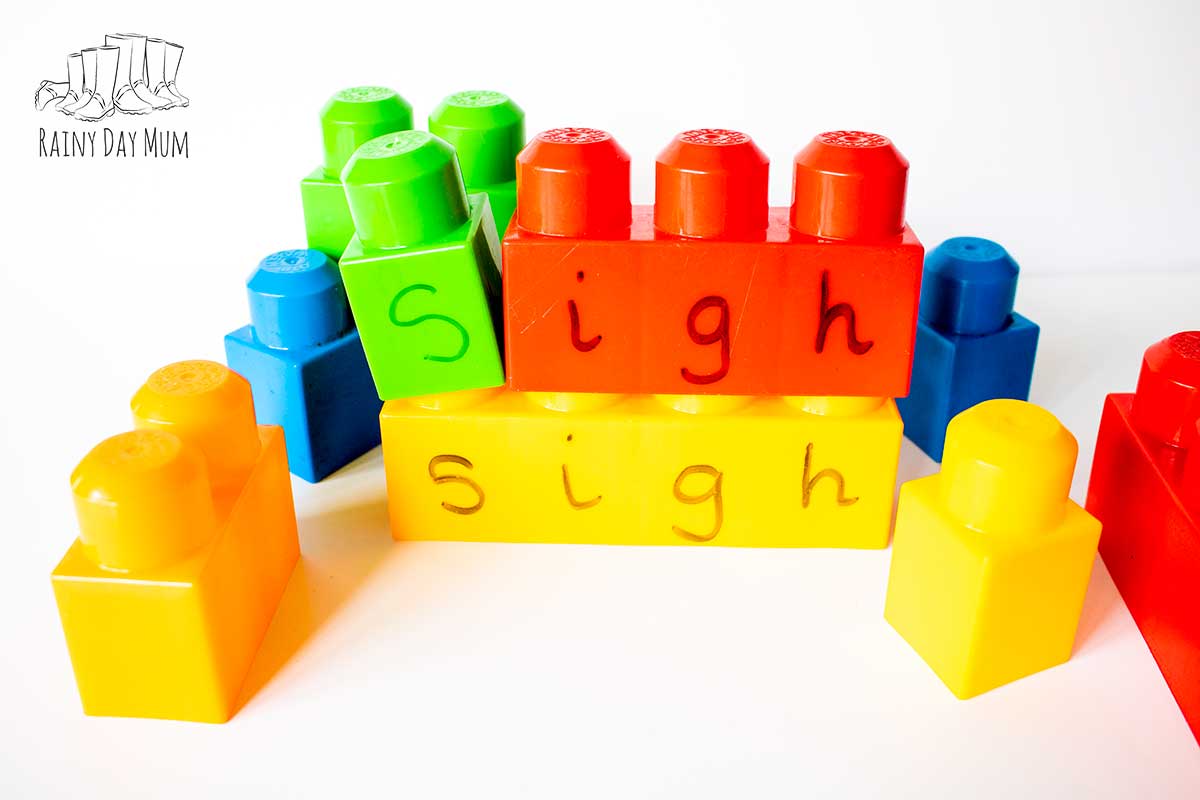
As they learn more sounds, you can extend this activity further to read and spell longer words.
More Learning Letters and Early Reading Activities for Kids

- Dinosaur Sand Tray and FREE Printable Alphabet Cards
Cerys Parker
Cerys is a marine biologist, environmental educator, teacher, mum, and home educator from the UK. She loves getting creative, whether it is with simple and easy crafts and ideas, activities to make learning fun, or delicious recipes that you and your kids can cook together you’ll find them all shared here on Rainy Day Mum.
Word formation is of crucial importance in language learning. It gives a chance to enrich the vocabulary with the help of already-known roots and words. In this article, we will discuss affixation (adding suffixes and prefixes to the root) as a great word formation tool.
1. It is important for learners to know how to form nouns, adjectives, verbs, and adverbs. If the teacher intends to devote the lesson to noun formation suffixes, he/she may prepare a poster activity with a chart of different noun formation suffixes.
Learners are given a pack of verbs and they need to classify these verbs according to the appropriate noun formation suffIx (e.g. move, friend, revise, appear). This is a very useful activity since the learners work in groups and they come up with the forms rather than being provided with them. See an example of the chart below.
The same activity can be applied while teaching adjective or verb formation suffixes or prefixes.
2. A maze, aimed at recapping suffixes and prefixes, is a great revision activity of word formation. Students try to exit the maze looking for words which follow the same word formation rules. The task might be the following:
- find the right path choosing adjectives whose opposites start with the prefix in-.
- find adjectives which form nouns by adding ance/ ity, etc
- find the words with the correct word formation.
Students are timed and it adds extra competition spirit into the activity.
See an example of the maze activity here.
3. 3. The teacher prepares two sets of word card: prefixes/suffixes and words that fit the chosen prefixes/suffixes to create new words. Students select one card from the Words pile and try to match it with the appropriate prefix /suffix to make a new word, note the new word down, put the Words card aside, and continue until they have no Words cards left. They can play individually/in pairs, in groups, against the clock or against each other to make as many correct words as possible.
The example provided here is targeted at revising noun suffixes -ment, -tion, and -sion.
Parts of Speech Bingo is an old but a tried-and-tested way of not only teaching but also revising word formation. Teacher selects words he/she intends the students to revise and prepares bingo cards. The game can be played either in this way when learners call out names of parts of speech (noun, verb, adjective, adverb), students cross out one word at a time (even if they have several nouns on their bingo card) or read out a sentence with a gap. Students who have the fitting word say it out loud and cross it out.
5. Students stand/sit in a circle, you (or any other student) select a category (word building suffix or prefix), students pass the ball around saying the words without repeating them and you monitor whether they are correct. The first person to say the wrong word/not say anything at all is eliminated (leaves the circle). The game goes on until there are two players left. Change suffixes/prefixes for each new round. It is a super engaging game and helps the learners dig deep to find a word which fits the category.
All these games are nice tools to help learners memorize word formation affixes. In order to reinforce the material, learners may be asked to come up with sentences where they need to use some of the given words, make up stories, ask questions to their partners. In this way, the knowledge of these words seems more purposeful to them and they enjoy this great way of expanding their vocabulary.
In this post regular contributor, Lauren of Teacher Types, shares seven playful ideas for encouraging children in the early years of school to experiment with building words with a range of materials.
“My child knows the Alphabet… Now what?”
Word building is a crucial step between knowing the letters of the alphabet and being able to write. The ideas I’m sharing today allow children to use hands on materials to experiment with arranging letters in different ways to create simple words. This process is much easier for young children than holding a pencil in their hand and having to remember how to form the letter shape, as well as which letters go together to make the word.
I recommend starting with commonly used, high frequency c/v/c (consonant/vowel/consonant) words because they are easier to sound out (eg mum, dad, dog, cat).
1. Bottle top letters
A very cool recyclable, there are so many opportunities to learn with bottle tops, including beginning word building. I usually start with a small group of letters (s a t i p n), and then move onto the second group of letters shown above (I use the Jolly Phonics program). Each student in my class has their own zip lock bag with a bottle top collection (we are always very careful at pack up time to make sure we have each letter and no doubles!).
2+3. Magnet & Foam Bath Letters
Incidental learning can be such a powerful thing – and having letters around the home such as these can provide great opportunities for word building. We have lower case magnets on our fridge and capital foam letters in the bath. At school, we teach lower case letters first, however children are usually exposed to various capital letters before they start school.
4. Foam Letter Stickers
These foam letter stickers are such a lovely tactile material. I ordered these ones from Clever Patch and use them in the classroom all the time.
5. Alphabet Pebbles
You’ll notice with these Alphabet Pebbles that in addition to the single sounds I’ve also made two-letter blends (or diagraphs) such as sh, ch, th, ee and oo. This takes word building to another level. I purchased these pebbles from Bunnings and simply wrote the letters on with permanent marker.
6. Duplo Letters
Duplo is a fantastic tool for teaching word families. The top Duplo brick has one letter on each side of it, while the bottom two bricks stay the same. The child is able to move the top brick to create different rhyming words.
7. Magazine Letters
Who remembers doing this when they were at school? It’s an oldie but a goodie. Firstly, young children can enjoy looking and searching for various letters through the magazines and then begin sticking them together to make words. This is challenging as awhole class activity – but great for small groups or an activity you and your school aged child can enjoy doing together at home.
Extending the Learning
If your child is showing signs of writing readiness or interest in writing the words they are making with these playful materials, you can encourage them to copy the words they’ve created with a variety of interesting writing materials – whiteboards, markers, special pens, crayon resist, rainbow writing, chalk, typing on the computer etc.
Learning the English language can be tricky, and it’s helpful for parents to understand the process of how early reading and writing happens. It will come naturally for some children, and may take a little longer for others, but it is truly magical when you see that penny drop and your child begins reading and writing independently.
You may also like these Alphabet Learning Ideas…
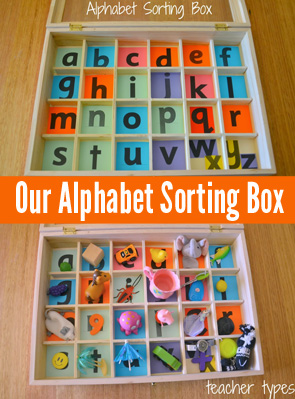
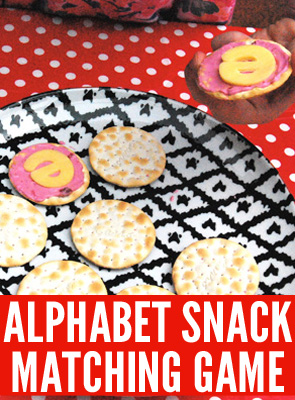

Lauren Hunt is an Early Childhood Teacher who currently works part time teaching children in their first year of school. She is also mum to a two year old daughter. Lauren is passionate about play-based, hands-on learning and is certainly kept busy by her energetic toddler!


